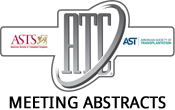2017 American Transplant Congress
The Safety and Efficacy of Directly-Acting Antivirals with or without Ribavirin for HCV Genotype 1 Infection: A Systematic Review and Meta-Analysis.
The First Affiliated Hospital of Sun Yat-sen University, Guangzhou, China
Previous studies have reported that ribavirin-free regimens are effective for treating chronic hepatitis C virus genotype 1 infection. However, the efficacy and safety of ribavirin-free…2017 American Transplant Congress
HCV+ Waitlist Candidates More Likely to Die Waiting for Kidney Transplant from HCV- Donor.
1University of Alabama at Birmingham, Birmingham; 2University of Pennsylvania, Philadelphia
Background: HCV-infected ESRD patients derive a significant survival benefit from kidney transplantation (KT) over remaining on dialysis. Given the high mortality rates on dialysis and…2017 American Transplant Congress
Access to Simultaneous Pancreas and Kidney Transplant (SPK) Should Not Be Restricted to BMI > 28.
SUNY Upstate Medical University, Syracuse, NY
Background: Currently, UNOS guidelines require that uremic, insulin-dependent type 1 diabetic patients have a body mass index (BMI) < 28m/kg2 in order to be eligible…2017 American Transplant Congress
Tolerant Pediatric Liver Transplant (LT) Recipients (TOL) from WISP-R (NCT00320606) Split into Two Phenotypically Distinct Groups by PD1 Expression on CD4+ T Cells at Baseline, Prior to Immunosuppression Withdrawal (ISW).
Background: Combinations of cell surface markers such as PD1, CD57, and/or KLRG1 identify T cells that may fail to respond to cognate antigen challenge –…2017 American Transplant Congress
Acute Mouse CMV Infection Abrogates Transplant Tolerance by Modulating Myeloid Cell Differentiation and Function: A Possible Role for Transcription Factor RORγt.
Cytomegalovirus (CMV) infection has long been associated with graft-dysfunction and rejection in transplant-recipients. Nevertheless, precise understanding of underlying molecular mechanisms remains unclear. Here, we investigated…2017 American Transplant Congress
BK Virus Infection and Risk of Urinary Tract Cancers Among Kidney Transplant Patients in the Transplant Cancer Match Study.
Background: Recent case series describe expression of BK virus (BKV) in tumor tissue obtained from renourinary cancers in kidney transplant recipients (KTRs). Thus, BKV may…2017 American Transplant Congress
Employment Patterns After Kidney Transplantation: Rates, Contributing Factors, and Outcomes.
Background: The costs of productivity lost in transplant patients poses a concern, as a significant number of patients are of working age. Furthermore, healthcare and…2017 American Transplant Congress
Increased Long-Term Mortality 20 years After Living Kidney Donation.
Living kidney donors are healthy at the time of donation. Consequently, a long observation period is necessary to detect possible detrimental effects of donation. Most…2017 American Transplant Congress
Increased Ischemic Inflammation Induces Recipient Endogenous Memory CD4 Cell-Graft Dendritic Cell Interactions to Provide Help for Activation of Endogenous Memory CD8 T Cells.
Immunology, Cleveland Clinic, Cleveland, OH
Memory T cells provide protection against recurrent pathogens, but memory T cells with donor-reactivity pose a major barrier to successful allograft transplant and tolerance induction.…2017 American Transplant Congress
Composite Prognostic Score Improves Clinical Benefit in Kidney Recipients Receiving Standard of Care Therapy for Antibody-Mediated Rejection.
Paris Translational Research Center for Organ Transplantation, Paris, France
There is a marked heterogeneity in AMR patients' prognosis after SOC treatment including plasma exchange (PE) and intravenous immunoglobulins (IVIG). We investigated whether the use…
- « Previous Page
- 1
- …
- 20
- 21
- 22
- 23
- 24
- …
- 181
- Next Page »
